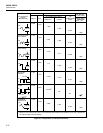
2620A, 2625A
Users Manual
5-4
Verify the trigger type over the computer interface by sending the query:
TRIGGER?
Single scans can be triggered via the RS-232 interface or the IEEE-488 interface by
sending the *TRG command. Note that the IEEE-488 interface GET command can be
used only when the IEEE-488 interface is enabled.
Note
If the instrument is in the remote state without front panel lockout (i.e.,
REMS), a *TRG can be generated from the front panel by pressing Q.
Both External and Monitor Alarms Disabled (Type 0)
External trigger input is disabled (Front Panel OFF, Computer Interface TRIGGER=0).
The *TRG and GET commands can still be used, and only normal scan interval
triggering can be used. If the scan interval is 0:00:00, continuous scanning results. Also,
a small scan interval (specifying a time less than that required by the instrument to
complete a full scan) effectively becomes continuous scanning. The number of channels
in the scan and the types of measurement determine the time necessary to complete one
scan.
External Trigger Enabled (Type 1)
This corresponds to the Front Panel ON or Computer Interface TRIGGER=1 setting.
When External Trigger is enabled, a low signal on the rear panel TR terminal affects
scanning as follows:
• If the scan function has already been activated, the trigger signal causes a single set
of scan measurements to be taken. This feature is convenient in cases where you
want to collect normal scheduled scans, as well as scan measurements in response to
some abnormal situation. When the condition arises, a trigger signal can be sent to
the instrument, causing it to take an extra set of scan measurements.
• If scan measurements are occurring when the trigger requesting a single scan arrives,
this request for another scan is ignored. (This stipulation applies whether the scan in
progress was initiated by the scan interval timer, a command over the computer
interface, or from a previous external-trigger signal.)
• If the instrument is in Inactive Mode, or just the Monitor function is selected, the
low trigger signal enables interval scanning. Scans are executed at the specified scan
interval. (If the scan interval is 0, continuous scanning results; a small scan interval
time effectively becomes continuous scanning.) When the TR input returns high,
interval scanning is disabled. This feature is handy in cases where you want to begin
normal scheduled scans after the system under test has reached some particular
operating condition. When that condition arises, a trigger signal can be sent to the
instrument, causing it to begin interval scanning.
• If the instrument is in Configuration Mode, all external trigger signals are ignored.
The instrument must be in Inactive Mode or Active Mode before any external trigger
signal will be recognized.
The external trigger accepts a contact closure or logic low signal; the input is non-
isolated and TTL compatible. Note that scanning is enabled on the falling edge of the
trigger signal. This trigger signal must be held low for a minimum of 5 microseconds; it
must also have previously been unasserted (high) for at least 100 milliseconds. Refer to
Figure 5-1. Signal level constraints are as follows:
High 2.0V min., 7.0V max.
Low -0.6V min., 0.8V max


















